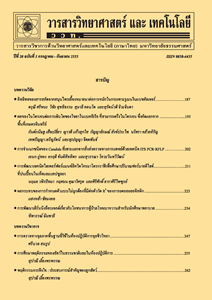การประเมินลักษณะทางกายภาพของข้าวเป็นหมันเนื่องจากอุณหภูมิเพื่อใช้เป็นสายพันธุ์แม่ในการพัฒนาข้าวลูกผสมในประเทศไทย
Main Article Content
Abstract
Abstract
Rice is one of the most important food crops. One approach to improve food production is the use of hybrid rice. The identification and application of the temperature-sensitive genic male sterility (TGMS) system provide a great potential for improving hybrid production because most of TGMS lines are sterile at high temperatures but are fertile at low temperature conditions. In this study, we obtained 7 TGMS lines from International Rice Research Institute (IRRI), Philippines. We evaluated agronomic traits of the 7 exotic TGMS lines, determined adaptability to Thai environments of these exotic TGMS lines, identified temperatures and time for their sterility and fertility in selected areas. Our results showed that these exotic TGMS lines had agronomic traits similar to Thai elite lines. They adapted well to Thai environments in all tested cropping and locations. In central area where we planned for hybrid production, these exotic lines were completely sterile in summer and most of the year, and several of these lines were fertile with reasonable seed setting in winter, suggesting that several of these exotic TGMS lines probably can be used as female parents for hybrid rice development in Thailand.
Keywords: rice; hybrid rice; temperature; anther; sterility, temperature-sensitive genic male sterility (TGMS)
Article Details
References
[2] Tu, J., Zhang, G., Datta, K., Xu, C., He, Y., Zhang, Q., Khush, G.S., Datta, S.K., 2000, Field performance of transgenic elite commercial hybrid rice expressing Bacillus thurigiensis-endotoxin, Nat. Biotechnol. 18: 1101-1104.
[3] Virmani, S.S., Sun, Z.X., Mou, T.M., Jauhar, A.A., Mao, C.X., 2003, Two-Line Hybrid Rice Breeding Manual, Los Banos (Philippines), International Rice Research Institute, 88 p.
[4] Akagi, H., Nakamura, A., Misono, Y.Y., Inagaki, A. and Takahashi, H., 2004, Positional cloning of therice Rf-1 gene, a restorer of BT-type cytoplasmic male sterility that encodes a mitochondia-targeting PPR protein, Theor. Appl. Genet. 108: 1449-1457.
[5] สุทัศน์ ศรีวัฒนพงศ์, 2552, การปรับปรุงพันธุ์พืช, สำนักพิมพ์มหาวิทยาลัยเกษตรศาสตร์, กรุงเทพฯ.
[6] Latha, R., Thiyagarajan, K. and Senthilvel, S., 2004, Genetics, fertility behaviour and molecular marker analysis of a new TGMS line, TS6, in riceม Plant Breed. 123: 235-240.
[7] เทพสุดา รุ่งรัตน์, สุทัศน์ จุลศรีไกวัล, ดำเนิน กาละดี, อโณทัย ชุมสาย, 2553, ความดีเด่นของผลผลิตและลักษณะอื่นที่เกี่ยวข้องในข้าวลูกผสมชั่วที่ 1 ระหว่างข้าวพันธุ์ดีของไทยกับข้าวสายพันธุ์เกสรเพศผู้เป็นหมันแบบไวต่ออุณหภูมิ, ว.เกษตร 26: 79-84.
[8] Peng, H.F., Chen, X.H., Lu, Y.P., Peng, Y.F., Wan, B.H., Chen, N.D., Wu, B., Xin, S.P. and Zhang, G.Q., 2010, Fine mapping of a gene for non-pollen type thermosensitive genic male sterility in rice (Oryza sativa L.), Theor. Appl. Genet. 120: 1013-1020.
[9] Zhou, H., Zhou, M., Yang, Y.Z., Li, J., Zhu, L.Y., Jiang, D.G., Dong, J.F., Liu, Q.J., Gu, L.F., Zhou, L.Y., Feng, M.J., Qin, P., Hu, X.C., Song, C.L., Shi, J.F., Song, X.W., Ni, E.D., Wu, X.J., Deng, Q.Y., Liu, Z.L., Chen, M.S., Liu, Y.G., Cao, X.F., Zhuang, C.X., 2014, RNase ZS1 processes UbL40 mRNAs and controls thermosensitive genic male sterility in rice, Nat. Commun. 5: 4884-4892.


